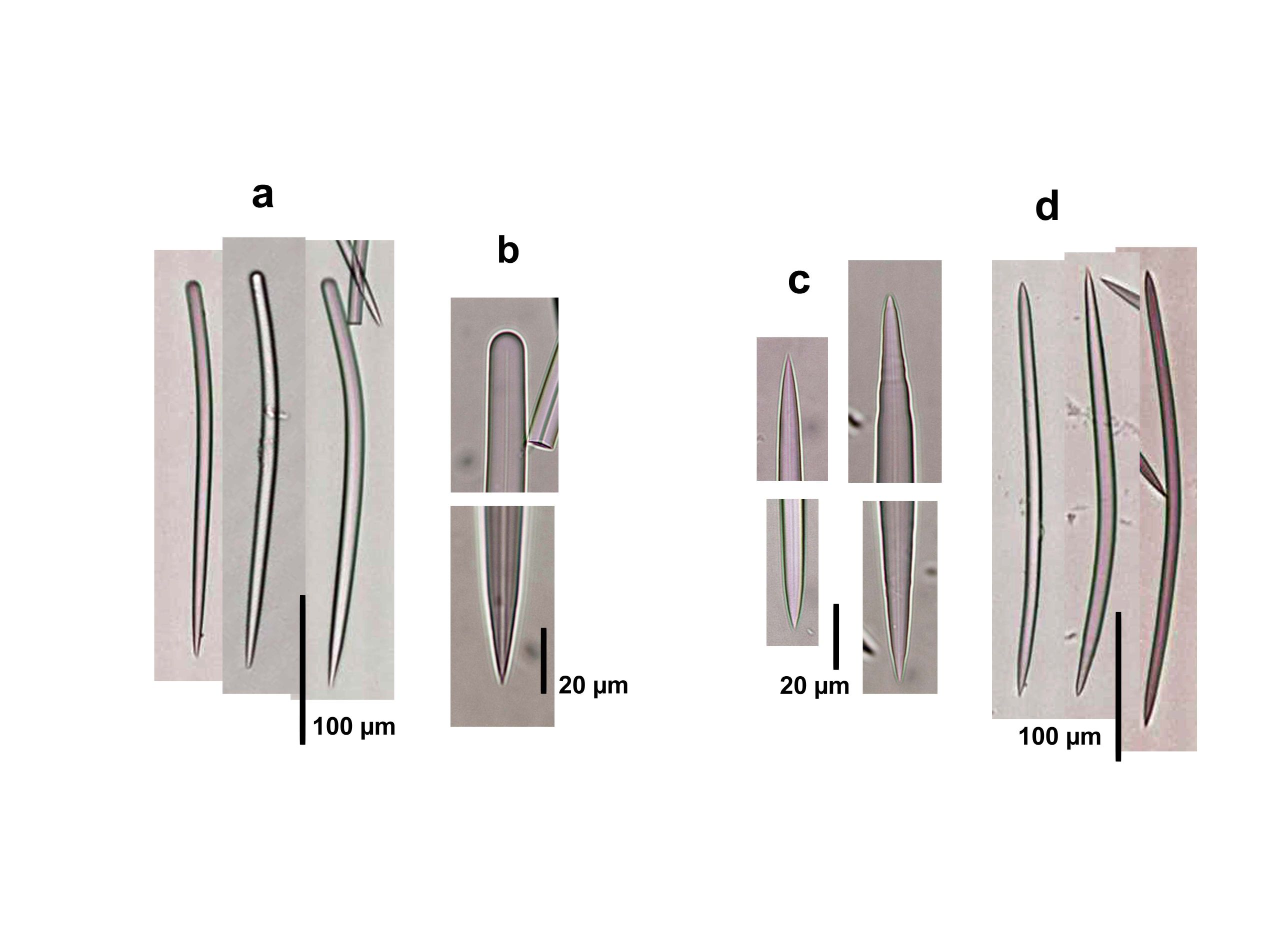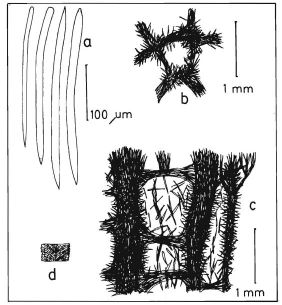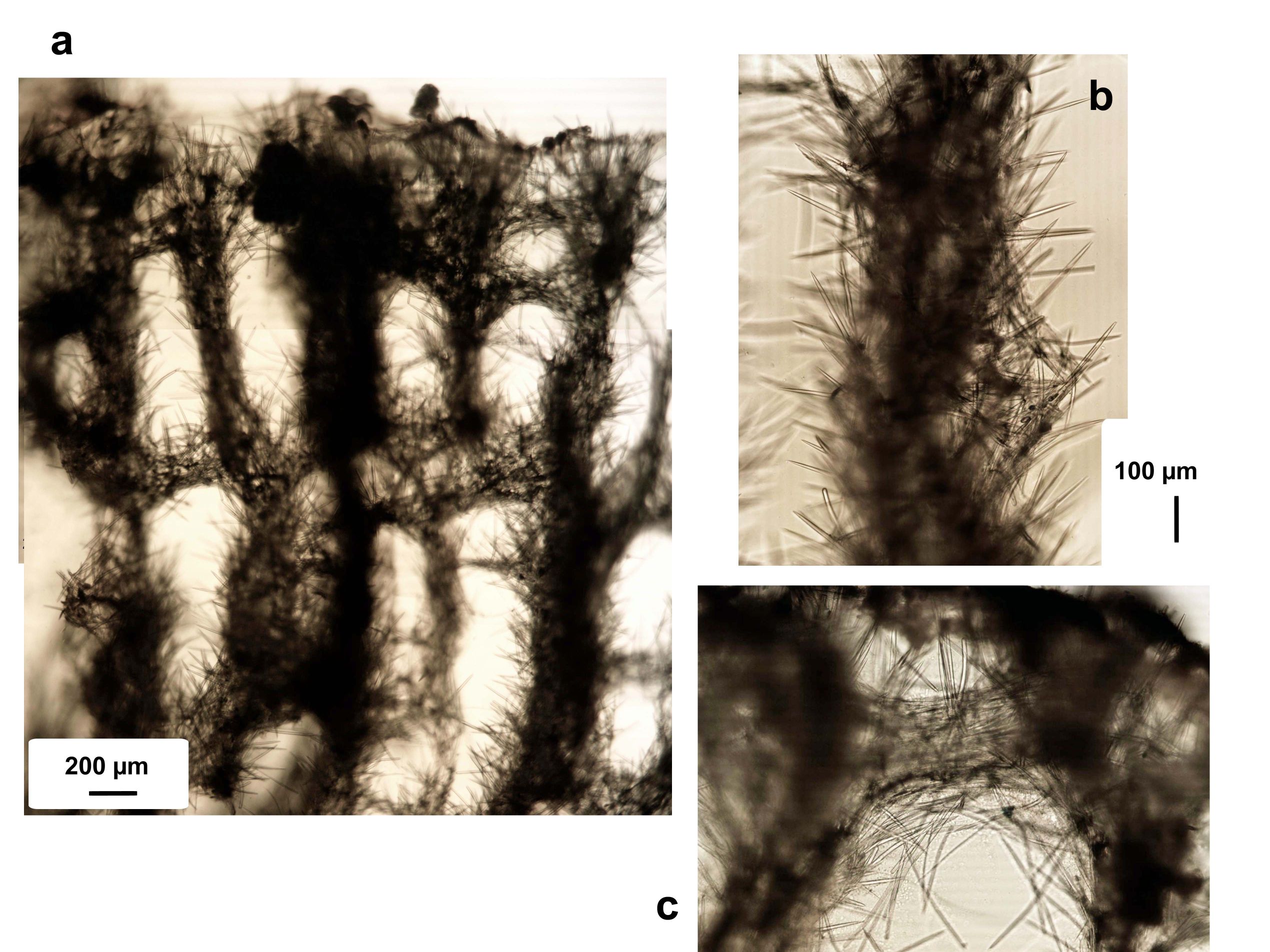the Sponge Guide - www.spongeguide.org
Observed Characteristics:
red
orange
branching
bushy
encrusting
fan
lobate
massive
crumbly
tough
Bahamas
Colombia
United States
Species Description and Notes
Description: Small masses to erect clubs or thick lamellae; large specimens can form a bouquet of branches thickened at the ends. Size from a few cm wide and tall, to 25-30 cm tall or more when branching. At Santa Marta, Colombia, it is always thickly encrusting, 2-3 cm thick, up to 20-25 cm in diameter. Surface is usually smooth, microspined, although it may be more strongly spined in elevated portions; oscules flush to the surface or slightly elevated, scattered, or aligned on the upper ridges where these occur. External color is bright red scarlet to orange; internal color orange. Consistency firm, somewhat compressible and flexible, but breaks or crumbles when forced. When handled, specimens release abundant mucus. Skeleton as a vertically elongated prismatic reticulation of thick ascending and diverging columnar multispicular tracts, 100-500 µm wide, separated up to 300 µm, interconnected every 175-1,225 µm by transversal spicular tracts, with less packed with spicules, 50-350 µm thick. All tracts are strongly echinated by spicules. At the surface, ascending tracts end in spicule brushes that support the organic pinacoderm. Spicules are: (1) curved styles with smooth heads and acute to slightly telescopic ends, 200-300 µm long by 4.5-13 µm wide; (2) curved, hastate oxea, with short ends, usually slightly asymmetric, slightly longer but thinner than the styles, 260-340 µm long by 7,5-12 µm thick.
Notes: This is a shallow to deep reef species, living usually exposed. Previously known as Pseudaxinella lunaecharta (Ridley & Dendy, 1886) (e.g., Wiedenmayer, 1977; Zea, 1987), it was synonymized to Pseudaxinella reticulata (Ridley & Dendy, 1886) from Brazil by Alvarez et al. (1998), which was then transferred to genus Dragmacidon by Alvarez & Hooper (2002). However, we have found that there are two distinct morphotypes that fall under the current definition of D. reticulatum. From our examination of type (BMNH 1887.5.2.11) and other material, one morphotype would correspond to the actual D. reticulatum, also pictured here, and the other into D. lunaecharta sensu Wiedenmayer (1977). Dragmacidon reticulatum is clearly distinct from D. "lunaecharta" in overall shape and spicule characteristics. They coexist in some areas (Stirrups Cays, Bahamas, Santa Marta, Colombia). D. "lunaecharta" has a smoother surface and often grows erect, while D. reticulatum has a more elaborated surface, always with thick spines, and is predominantly thickly encrusting and slightly tougher. In coexisting specimens, typically D. "lunaecharta" has smaller spicules, with the oxea larger than the styles, while D. reticulatum has larger spicules and some of the styles as long as the oxea. The skeleton of D. reticulatum is made of thicker ascending spicule tracts, more widely separated, and projecting on the surface as spines. Some of Wiedenmayer (1977) specimens of P. lunaecharta have the aspect (see his pl. 31, fig. 10, lobulated habit) and the larger spicules (e.g., Fig. 156A) of D. reticulatum, indicating that perhaps he and Alvarez et al. (1998) inadvertedly lumped these two species together. Since the original Dragmacidon lunaecharta (Ridley & Dendy, 1886) is from the E. Atlantic and a clearly distinct species according to Alvarez et al. (1998), the Caribbean material requires another name, which needs to be searched among the various synonyms currently ascribed to D. reticulatum. [Note of caution: in a previous edition of this guide, we switched the names for the two morphotypes of Dragmacidon: D. reticulatum for the current D. "lunaecharta" and D. explicatum (Wiedenmayer, 1977) for the actual D. reticulatum (according to Alvarez et al., 1998, and to our examination of types, D. explicatum is a junior synonym of D. reticulatum.)]
Author Reference: (Ridley & Dendy, 1886)
Link: World Porifera Database
Tissue and Spicule Images

Spicule Images: a) Styles; b) ends of styles; c) ends of oxea; d) oxea. Sample from the Bahamas.
Source Specimen: http://www.spongeguide.org/ thumbs/00022/00972.JPG

Spicule Images: Drawings of spicules and of skeleton of specimens from Colombia. a) styles; b) tangential view of the ectosome; c) section perpendicular to the surface; d) longitudinal section of a branch showing the ascending and radially diverging skeletal frameword (from Zea, 1987, figure 70, as Pseudaxinella lunaechaarta).
Source Specimen: http://www.spongeguide.org/ thumbs/00115/01860.jpg

Tissue Images: a) Perpendicular section at the surface; b) magnification of an ascending tract; c) magnification of an interconnecting tract. Sample from the Bahamas.
Source Specimen: http://www.spongeguide.org/ thumbs/00022/00972.JPG
Images
Dragmacidon "lunaecharta"
Location: Bahamas, Stirrups Cays, N Berry Islands
Photographer: Sven Zea
Location: Bahamas, Stirrups Cays, N Berry Islands
Photographer: Sven Zea
Location: Bahamas, Little San Salvador
Photographer: Sven Zea
Location: Bahamas, Stirrups Cays, N Berry Islands
Photographer: Sven Zea
Location: Bahamas, Stirrups Cays, N Berry Islands
Photographer: Sven Zea
Location: Bahamas, Stirrups Cays, N Berry Islands
Photographer: Sven Zea
![<i>Dragmacidon "lunaecharta"</i> <br />[Bahamas, Stirrups Cays, N Berry Islands]](thumbs/00034/01132.jpg)
Location: Bahamas, Stirrups Cays, N Berry Islands
Photographer: Sven Zea
![<i>Dragmacidon "lunaecharta"</i> <br />[Bahamas, Stirrups Cays, N Berry Islands]](thumbs/00034/01140.jpg)
Location: Bahamas, Stirrups Cays, N Berry Islands
Photographer: Sven Zea
![<i>Dragmacidon "lunaecharta"</i> <br />[United States, Florida Keys]](thumbs/00110/01351.jpg)
Location: United States, Florida Keys
Photographer: Joseph Pawlik
![<i>Dragmacidon "lunaecharta"</i> <br />[Colombia, Islas del Rosario]](thumbs/00115/01855.jpg)
Location: Colombia, Islas del Rosario
Photographer: Sven Zea
Location: Colombia, Santa Marta
Photographer: Sven Zea
![<i>Dragmacidon "lunaecharta"</i> <br />[Colombia, Santa Marta]](thumbs/00115/01857.jpg)
Location: Colombia, Santa Marta
Photographer: Sven Zea
![<i>Dragmacidon "lunaecharta"</i> <br />[Colombia, Santa Marta]](thumbs/00115/01858.jpg)
Location: Colombia, Santa Marta
Photographer: Sven Zea
![<i>Dragmacidon "lunaecharta"</i> <br />[Colombia, Santa Marta]](thumbs/00115/01860.jpg)
Location: Colombia, Santa Marta
Photographer: Sven Zea
![<i>Dragmacidon "lunaecharta"</i> <br />[Colombia, Islas del Rosario]](thumbs/00115/01861.jpg)
Location: Colombia, Islas del Rosario
Photographer: Sven Zea
Location: Colombia, Santa Marta
Photographer: Sven Zea
Location: Colombia, Santa Marta
Photographer: Sven Zea
Location: Colombia, Santa Marta
Photographer: Sven Zea
![<i>Dragmacidon "lunaecharta"</i> <br />[Colombia, Islas del Rosario]](thumbs/00115/01939.jpg)
Location: Colombia, Islas del Rosario
Photographer: Sven Zea